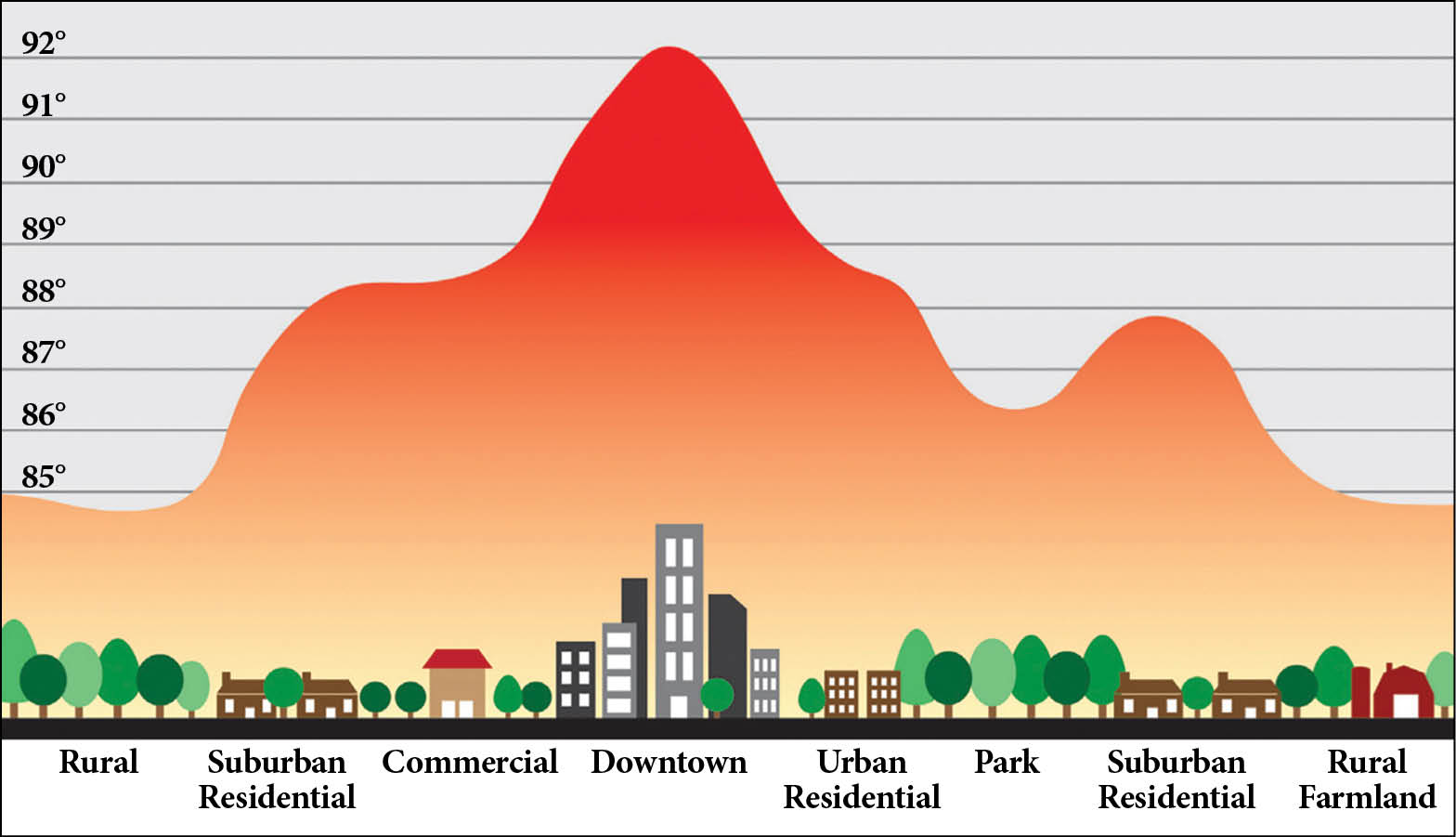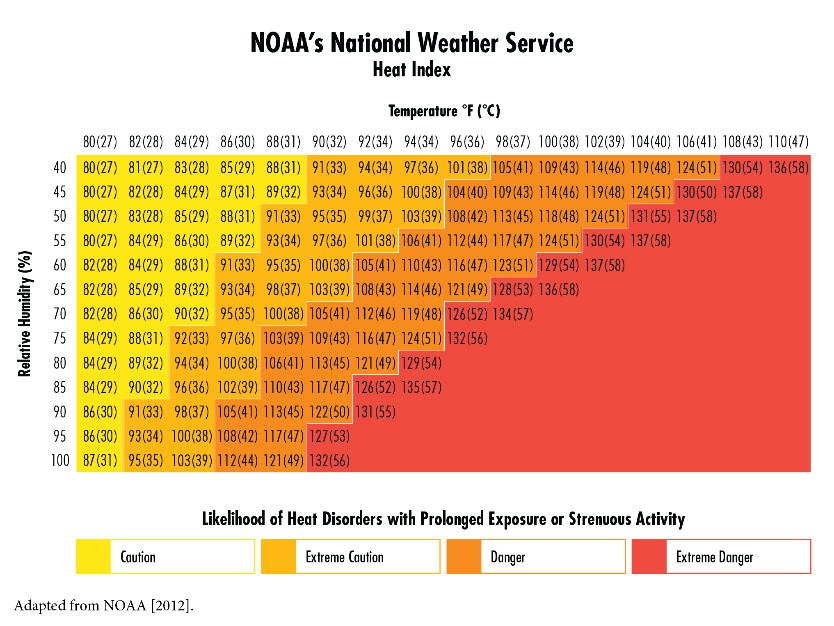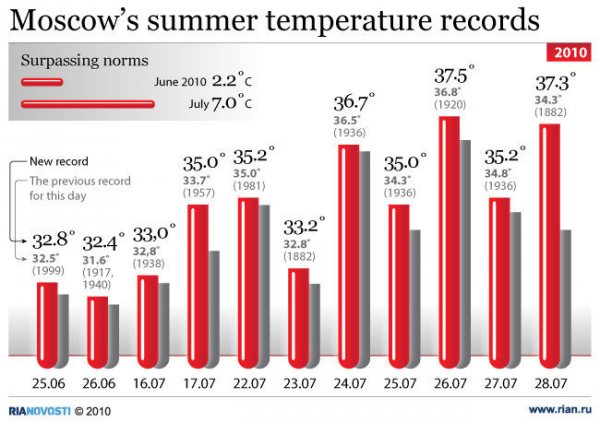Heat
Heat
Heat waves are periods of unusually high temperatures and humidity that last for days or weeks. High pressure systems can trap air in one place as it warms, which can lead to a heatwave. Over the past four decades, there has been an increase in the frequency of heatwaves, especially high humidity heat waves featuring both high humidity and high nighttime temperatures.
Effects of Extreme Heat
Extreme heat is the most deadly natural hazard, killing more than 600 people per year in the U.S on average. On the National Oceanic and Atmospheric Administration’s list of US history’s deadliest disasters, heat waves are four of the top ten. The combination of high heat and humidity can cause, in humans, heat stress, heat stroke, and death. Heat stress is a condition that occurs when the human body is unable to cool itself effectively. Normally, the body regulates temperature through sweating, but when humidity is high, sweat will not evaporate which can potentially lead to heat stroke. Heat stroke results in a prolonged loss of consciousness, confusion, quickened heart rate and even convulsions, and can be life threatening.
Young children and the elderly are at a greater risk for heat stroke. Additional populations at elevated risk include those who are overweight, physically immobile, have had a prior heatstroke, who work outdoors. Men, because of their larger size and greater propensity to have outdoor jobs, are also more susceptible to heat stroke and dehydration. Several other conditions can arise as a result of prolonged exposure to high temperatures, such as heat cramps or heat syncope which is a sudden, short loss of consciousness. Livestock can also be affected by and die from heat stroke. In addition, some crops require cool night temperatures, and will not mature or grow when under heat stress night and day.
Urban Heat Island Effect
Urban populations carry a greater risk during a heatwave because urban temperatures are typically higher than the surrounding landscape. Urban areas generally have higher temperatures because of less tree cover, more surfaces like asphalt that absorb heat, and lower wind speeds. These factors combine to produce urban temperatures that average 2° to 5° F more than surrounding areas, and potentially up to 22° F more on calm evenings. This phenomenon is known as Urban Heat Island Effect.

Measuring Heat Waves
Temperature alone is insufficient to describe the stress that hot weather places on homeostasis, the body’s ability to maintain a constant internal temperature. NOAA created the Heat Index to describe how the body might “feel” on an apparent temperature scale. The Heat Index uses 20 variables based on people and their biological reactions to meteorological conditions. Heat index is calculated as the relationship between air temperature, humidity and skin temperature.

Weather forecasts that inform you about extreme heat use three different levels to describe the level of danger. A Heat Watch occurs when the conditions are favorable for heat to meet or exceed the local warning criteria in the next 12-24 hours. Heat Warnings are when heat values are forecasted to meet or exceed warning criteria for at least a two day period. A Heat Advisory is when the hazardous heat conditions have begun or will begin in 36 hours. Heat Advisory conditions may become life-threatening.
2010 Russia Heat Wave
In July and August of 2010, Russia experienced a catastrophic heat wave that lasted longer than 60 consecutive days, making it the longest, and most intense heatwave in a millennium. For several weeks the country was plagued by massive forest fires, and ultimately the heatwave resulted in approximately 55,000 deaths, and a blow of $7-$15 billion dollars (US Dollars) in crop, livestock and fire damages to their GDP (1%).

Top Five Deadliest Heat Waves (US Centers for Disease Control)
| Heat Event | Death Toll |
| Europe, 2003 | 71,310 |
| Russia, 2010 | 55,736 |
| Europe, 2006 | 3,418 |
| India, 1998 | 2,541 |
| India, 2015 | 2,500 |
Heat and Climate Change
There are numerous studies that show that human-induced climate change has increased the frequency and impact of heat waves globally. Since the 1950’s the number and duration of heat waves has increased internationally. In the United States, record high temperatures over the past decade have outnumbered record lows by a ratio of 2:1. Electricity consumption increases with temperature increases as people try to cool their homes to a comfortable temperature. The average temperature around the world has increased 1.4 degrees Fahrenheit since 1880, much of this in the recent decades. Coral Reefs have been bleaching and dying off, ice caps and glaciers are melting, and there has been an upsurge in the frequency and intensity of extreme weather events. People living on the coast can expect sea levels to rise and displace their homes, and simultaneously they will experience more intense tropical storms. Though it seems like a small difference in temperature, the Earth is sensitive to even slight changes in climatic conditions.
